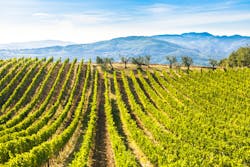Winemakers could reuse wastewater for irrigating vineyards
Winery wastewater is a viable option for irrigating vineyards, according to a new study.
Scientists at the University of California, Davis, wanted to find out whether the vines, the soil or even the wine would be harmed if wastewater from activities like washing bottles and cleaning floors were reused in this way.
They assessed winery wastewater samples at monthly intervals over two years at 18 wineries in the Napa and Lodi regions of California. Most wineries were already doing a good job of treating their wastewater through a series of retention ponds and other treatment systems, UC Davis said in the article.
Results suggested that, under the right conditions, winery wastewater is a viable water source to irrigate vineyards.
The research provides the first data to support the California wine industry’s potential reuse of treated winery wastewater.
“This is a good baseline data set to look at and say, ‘Now we know what’s in our wastewater and what we can do to deal with it before we put it on the grapes,'” commented lead author and UC Davis researcher Maya Buelow in the article.
“Vines are a high cash crop, and growers need to proceed with caution and gather site-specific soil and wastewater data, but there are wineries successfully doing this.”
In two studies published in the American Journal of Enology and Viticulture and the journal Agriculture Water Management, the scientists set out recommended conditions for the practice.
Buelow also pointed out that this form of wastewater reuse has wider applications, as many other segments of the food industry produce significant amounts of wastewater, such as dairy, pig, poultry and food processing operations. “There are opportunities for them to reuse wastewater, as well,” she said in the article.
